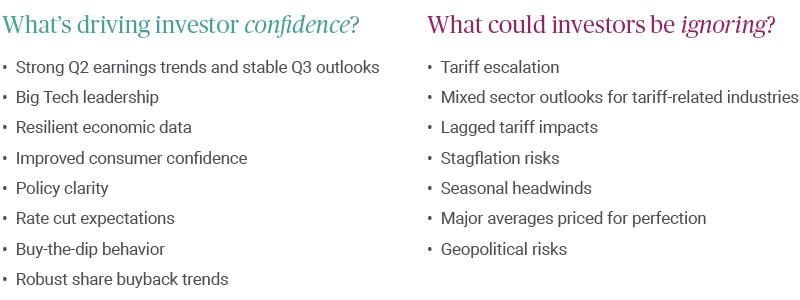Anthony Saglimbene, Chief Market Strategist – Ameriprise Financial
8/18/2025

Stocks have spent the summer near all-time highs amid a backdrop of strong corporate earnings, resilient economic data and recent policy developments.
Notably, investor sentiment continues to lean bullish, driven by a combination of fundamental strength and trading momentum. Yet, beneath the surface, we believe there are growing risks — particularly around trade policy, inflation and labor market dynamics — that investors may be underappreciating.
Below, we look at the factors fueling the recent stock gains and the risks that may disrupt their momentum.

What's driving investor confidence?
Here are some of the bullish dynamics that are fueling investor confidence:
- Strong Q2 earnings trends and stable Q3 outlooks: At the core of the current stock market rally sits strong corporate profitability. The second quarter earnings season has been a standout, in our view, with S&P 500 Index companies, in aggregate, handily beating analyst expectations.
- Big Tech leadership: Big Tech continues to lead on the profit front, fueled by secular growth in artificial intelligence (AI) and robust consumer/business demand.
- Resilient economic data: Recent economic data has supported the bullish tone among investors, despite a major downward adjustment in job growth over recent months. For example, headline inflation remains relatively tame and weekly jobless claims have stayed low, suggesting that the labor market, while softening, remains intact. Services activity, which drives the bulk of U.S. gross domestic product (GDP), continues to show resilience as well.
- Improved consumer confidence: Consumer confidence recently hit a five-month high, indicating that conditions remain favorable for corporate earnings and economic growth.
- Policy clarity: Policy developments have also added further fuel to the stock rally. The passage of the One Big Beautiful Bill has provided clarity on taxes and fiscal priorities, extended the debt ceiling, and increased spending on defense and border security.
- Rate cut expectations: Investors are also pricing in potential rate cuts from the Federal Reserve starting next month, with dovish commentary from some Fed officials reinforcing expectations for easier monetary policy ahead. The combination of fiscal clarity and potential monetary accommodation has helped investors look past trade concerns for the time being.
- Buy-the-dip behavior: With stocks at all-time highs, increased risk appetite among investors is also helping driving markets higher.
- Robust share buyback trends: Share buyback trends remain strong and healthy, further supporting equity prices and investor confidence, in our view.
What could investors be ignoring?
Below the surface, we believe risks to the growth outlook are forming. Here’s what markets may be overlooking:
- Tariff escalation: We believe trade policy remains a significant wildcard. The president has enacted new and higher reciprocal tariff rates on a host of countries this month, including a 50% rate on imports from India.
- Mixed sector outlooks for tariff-related industries: Tariffs can act as a tax on consumption, and there is growing evidence that companies are beginning to “slowly” pass these costs on to consumers. If this trend accelerates, it could dampen demand and corporate margins over time, particularly in sectors like autos, retail, apparel, furniture, and industrials.
- Lagged tariff impacts: The average U.S. tariff rate has surged 6.8% since the end of last year to over 9.0% — the fastest pace of increase since the Smoot-Hawley era. In addition, a 100% tariff rate on semiconductor imports was announced this month, though exemptions were granted to firms investing in U.S. production. And a phased-in pharmaceutical tariff — potentially rising to 250% — was also previewed in August.
- Stagflation risks: The aforementioned tariff developments raise concerns about stagflation, which is when economic growth slows and inflation increases simultaneously. The recent New York Fed's Survey of Consumer Expectations revealed rising inflation expectations at both the 1-year and 5-year horizons. Further, continuing jobless claims recently reached their highest level since November 2021, reinforcing concerns about a weakening labor market. While investors are currently focused on strong earnings and AI-driven optimism, the risk of stagflation could become a larger concern in future months.
- Seasonal headwinds: Historically, the S&P 500 Index is more prone to bouts of weakness and drawdowns in August and September. However, stock performance in the front half of August has been positive this year.
- Major averages priced for perfection: Favorable future scenarios, such as anticipated Fed rate cuts, for instance, are already priced into stock valuations, meaning that stocks could face a drawdown if those scenarios don’t transpire as investors expect them to.
- Geopolitical risks: In addition to the persistence of trade uncertainty, geopolitical frictions that unexpectedly increase global tensions could have the potential to disrupt the market’s momentum.
Bottom line
The U.S. stock market is currently navigating a complex macroeconomic environment of strong corporate earnings and AI-driven optimism tempered by inflationary pressures and tariff uncertainties. For now, investors are focusing on what is in front of them, which is stronger-than-expected earnings growth, a durable AI secular theme and a still-firm economic backdrop. In our view, a balanced portfolio approach remains a prudent strategy, with the understanding that short-term dislocations may still present longer-term opportunities — provided the macro backdrop doesn't materially deteriorate.
Get personalized insights into your portfolio
Your Ameriprise financial advisor is here to help you understand how the current market environment may affect your investment portfolio and financial goals.